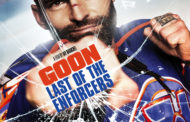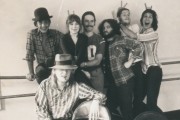 Red Army opens with an old clip of a pre-presidential Ronald Reagan speaking about the threat of the communist Soviet Union. It serves as a perfect introduction to this documentary, which tells the Cold War-era story about what was arguably the greatest hockey team in the history of the game: CSKA Moscow, the Soviet national team that was commonly called the “Red Army.” One of the main battlefields during the Cold War was athletics because dominance in sports was the USSR’s way of proving communist superiority — and there was no sport the Soviets were better at than hockey. Director Gabe Polsky examines the importance of hockey in the Soviet Union in a revealing documentary that is alternately poignant, humorous, and nightmarish.
Red Army opens with an old clip of a pre-presidential Ronald Reagan speaking about the threat of the communist Soviet Union. It serves as a perfect introduction to this documentary, which tells the Cold War-era story about what was arguably the greatest hockey team in the history of the game: CSKA Moscow, the Soviet national team that was commonly called the “Red Army.” One of the main battlefields during the Cold War was athletics because dominance in sports was the USSR’s way of proving communist superiority — and there was no sport the Soviets were better at than hockey. Director Gabe Polsky examines the importance of hockey in the Soviet Union in a revealing documentary that is alternately poignant, humorous, and nightmarish.
Although this documentary is titled Red Army, the main focus is the team captain, Slava Fetisov, who played on the team from 1978-1989 and then in the NHL until 1998 and has won just about every conceivable major hockey championship and award. It seems like Polsky started filming a documentary about the team in general, but soon realized that Fetisov had the most intriguing life story and focused on im. It also helps that Fetisov so epitomizes the no-nonsense, stern Russian stereotype that his interactions with Polsky are frequently comical.
Fetisov and several of his teammates explain how they were selected as children to play on the Soviet team and how they loved playing for Anatoli Tarasov, who built the Soviet hockey program and coached the national team until he was fired after the 1972 Winter Olympics (despite the USSR taking home the gold). He was replaced by the tyrannical Viktor Tikhonov, whose methods became increasingly intense and completely isolated the players from their families for months at a time. Fetisov’s growing resentment of the way Tikhonov treats him forms the major conflict of the documentary, even if Fetisov is still careful not to completely speak his mind about him.
Most Americans would probably assume that the climax of the film would be the 1980 Miracle of Ice (when the U.S. Olympic hockey team, made up of amateur and college players, beat the Soviet team). However, this isn’t about America’s hockey teams, and the 1980 Olympics are covered just 25 minutes into the documentary. One of the most moving parts of this documentary is how Polsky tells the story of the Miracle game. Polsky lets the original footage and Al Michaels’ calls tell the story and cuts to Fetisov, who says nothing but the tears welling up in his eyes say everything. Even if it was nearly 35 years ago and he would win many championships afterward, Fetisov is still haunted by that loss.
The real climax to the film comes during the collapse of the Soviet Union and Soviet players were offered the opportunity to play in the NHL for million-dollar contracts. Fetisov in particular had difficulty with getting a fair deal to play in the NHL because he was team captain and a national hero and the government feared that him playing in the NHL would serve as a symbolic victory for the U.S. Though any hockey fan will know that Fetisov did eventually play in the NFL and even won two Stanley Cups with the Detroit Red Wings, most will not know what he had to go through in order to get that chance.
Though Fetisov’s story is compelling in itself, the stories about the rest of his comrades (including the five-man “Green Unit” that are all considered some the greatest hockey players who ever lived) are really only explored as they relate to him. For a movie titled Red Army, I wanted to learn more about the inner workings of the team as a whole. But even as it is Red Army is one of the best sports documentaries I have ever seen, and I’m not totally a hockey guy — it’s just that fascinating.
RATING: An exceptional documentary that shows how sports and politics intersected in the lives of the Soviet Union’s greatest hockey players (8.5/10).















Recent Comments